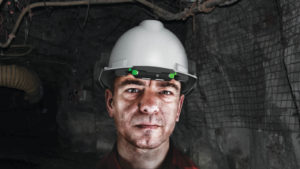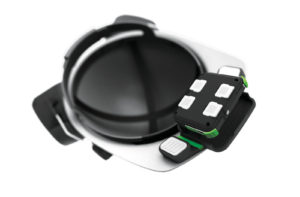In the mining industry, safety challenges demand the latest developments in wearable technology.

The Chilean mining disaster of 2010 saw 33 workers trapped 2,300 feet underground for 69 days. Their ordeal made headlines across the world, and amidst the jubilation of their survival there was a stark reminder that mining remains one of the most dangerous and extreme work environments on the planet. By its nature, the geographical terrain is harsh and unforgiving, and with mines that can reach depths of 2.9km (Canada) and 3.9km (South Africa), the challenges posed are both numerous and vital to industry health.
Wearable technology has become an increasingly important development for the mining industry in the Americas and worldwide. While mines extract everything from gold to copper, nickel and tin, with processes and equipment varying, there are three key issues that are common to all of them: safety, productivity and data gathering. Wearable technology is helping to provide solutions that save lives and offer higher efficiencies, but it is not without its challenges and complexities.
Putting fatigue to work
Mining industry priorities vary widely around the globe. A 2014-15 mining equipment survey by Timetric identified the top areas for future intended technology investment, signaling the largest region for each. Fatigue management was identified as a priority for African mining companies who, when surveyed, declared the intention to invest 84 percent of investment funds in fatigue-related technologies. In the Americas, responses from North American mining companies focused on collision avoidance and proximity detection (57 percent); companies in Latin America indicated more interest in remote control equipment and machine automation (50 percent). From respondents in Asia, software for mine management came in as the top investment category (54 percent); Europe and the former Soviet Union indicated most interest in investing in fleet management and monitoring (52 percent). The Australian mining industry looked to environmental monitoring and emissions management (35 percent).
“Rio Tinto goes mining for data” wrote Peter Ker, unable to resist the headline pun in The Sydney Morning Herald on Mar. 4, 2015. The occasion was the opening of the company’s state-of-the-art data analytics center in Pune, India, which was set up to harness the data gathered directly and indirectly by miners with sensory equipment covering almost every aspect of their work. The head of innovation and technology at the time, Greg Lilleyman, envisaged that “the center will help us predict the future through the use of advanced data analytics techniques to pinpoint with incredible accuracy the operating performance of our equipment.”
One of the wearable technology devices being used by Rio Tinto PLC , headquartered in London, is the SmartCap, developed by Australian company SmartCap Technologies. The device helps to monitor and guard against worker fatigue and prevent accidents, particularly with heavy machine operators. The “cap” is an electroencephalogram (EEG) Life Band that can be inserted inside a hard hat or other headwear and uses state-of-the-art brainwave technology to determine alertness or microsleeps. SmartCap works with Bluetooth, and progressive tracking builds it into a predictive technology with Fatigue Manager software providing real-time data to alert for fatigue issues.
Tracking and communication
Deloitte LLP in Toronto, Canada, has set up a Deloitte Wearables Group headed by John Wang, working to develop the “Connected Worker”: a 3-D real-time visualization and industrial communication tool linking workers underground with those above ground. Computers, GPS, sensors and other biometric technologies are being incorporated into miners’ clothing and accessories such as hats and watches. The company believes these wearable technology devices offer the potential to communicate with other workers as well as communicating the wearer’s vital signs to monitors above-ground, warning about hazards that might not be immediately evident, such as reduced air quality or the presence of toxic gases. From a financial perspective, the device could also offer the mining company cost savings on ventilation and temperature control in areas where it can be seen that workers are not present.
The Deloitte team has developed a Smart Helmet with Toronto-based Cortex Design Inc. that incorporates an array of sensors into a device that can fit different hat brim curvatures. The device enables IoT (Internet of Things) capabilities that include location tracking, environmental sensing (carbon monoxide, carbon dioxide, methane) and WiFi. Pointing to changes in China and the impact on commodity prices, Glenn Ives, Americas mining leader at Deloitte Canada, says that innovation is essential: “Rather than being optional, being bold may be the prerequisite to survival.”
Not all fatigue monitoring is undertaken during work. San Francisco-based Bridgecrest Medical has developed a solution to monitor workers before they enter the mine. Workers are assessed for major risk factors that affect the quality of sleep. A smartwatch measures various health factors such as biometrics, heart rate, quantity and quality of sleep, with the results fed into a secure analytics platform. An app then reveals low-, medium- and high-risk employees before the start of a shift, allowing just-in-time management decisions to be made. The intention is to prevent accidents from happening for workers, as well as to safeguard expensive mining equipment. (For example, mining vehicles need tires that can withstand rough terrain and heavy loads. The Letourneau L-2350 front loader tires, for example, are used for earth-movers in mining. Priced at around $63,000 each, they are reportedly the most expensive tire of that type in the world.)
Safety in numbers
Multinational professional services firm Ernst & Young (EY), in its annual report on the mining and metals industry, has identified productivity and retention of talented workers as key issues that are linked together. Wearable technology and the IoT are heavily focused on data collection and analysis, often in real time. EY has attributed declining productivity to a number of issues, including contributing factors of inexperienced and insufficiently trained employees, high employee turnover and an aging workforce. These are issues that cannot be ignored by the industry, as data management, communication and IoT are becoming the keystone for mining productivity worldwide.
Wearable technology has emerged through smart materials. As these technologies and products began to emerge in the commercial sector, they were referred to as “Smart Materials and Systems” for good reason—they were part of a system. The needs of the mining sector today require wearable technology not as a stand-alone solution, but as part of a larger system that includes robots, drones, artificial intelligence, sensors and big data. While wearable technology is a significant business sector in its own right, manufacturers must remember that their products are also part of a system that includes these other technologies. Design, manufacture and implementation in different industries will require knowledge of and perhaps partners in a number of different technological circles.
 TEXTILES.ORG
TEXTILES.ORG



